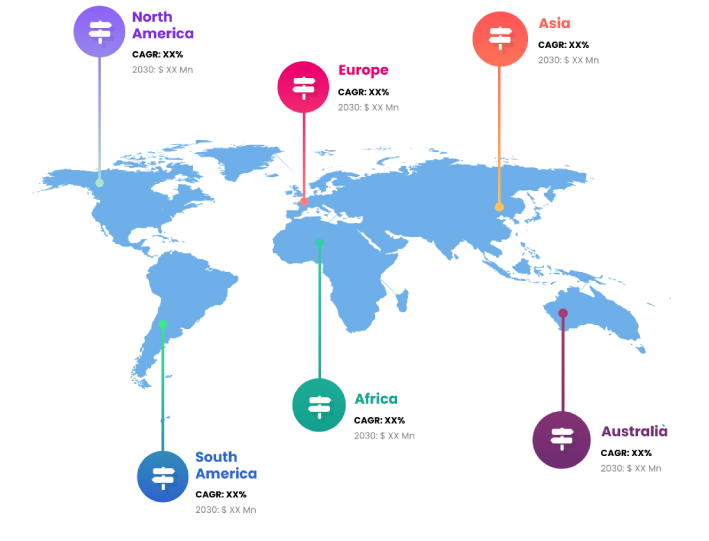
The increasing acceptance of mobile virtual network operator (MVNO) can be ascribed to affordable plans, flexible options, no credit checks, wide device compatibility, and customized plans. There have been many mergers, acquisitions, partnerships, and collaborations among the companies operating in the MVNO industry. For example, Spitfire Network Services Limited (a UK-based provider of fixed line voice, internet, and WAN services to business) announced a comprehensive MVNO arrangement with BT Wholesale (a UK-based telecom service provider) in July 2023. Through this collaboration, Spitfire's next-generation core network will be linked to BT Group's EE 4G and 5G Radio Access Network, allowing for increased safety, superior connection, and novel pricing options.
The rate of market expansion is anticipated to be driven by the increasing prevalence of mobile devices. By the end of 2021, GSMA predicts that 5.3 billion people, or around 67% of the world's population, will be mobile service subscribers. Most people in developing nations now have mobile phones, indicating future expansion will come from new subscribers, particularly among the young. About 70% of the world’s population, or 5.7 billion people, are predicted to be mobile phone customers by the end of the next five years. Most of these new users will come from Sub-Saharan Africa and Asia.
The mobile virtual network operators market is expected to expand in the coming years thanks to developments in technology such as machine-to-machine connections and cloud storage. It is predicted that mobile virtual network providers would increase income by providing more accessible and less expensive solutions in markets including entertainment, lifestyle, and productivity. Roaming services are just one of the many benefits that customers of mobile virtual network operators (MVNOs) enjoy while away from home. For instance, Lyca mobile provides low prices for international calls.
Sharing infrastructure is an attractive profit-maximizing strategy that can help both mobile virtual network operators and mobile network operators. Both MVNOs and MNOs stand to gain greatly from strategic partnerships that allow the former to leverage the latter's network infrastructure. By leveraging an existing, established network, MVNOs can drastically reduce their operational expenses while still providing their customers with a high quality service. At the same time, MNOs make the most of their infrastructure investments by monetizing unused network bandwidth. While allowing MVNOs to operate competitively and provide consumers with more affordable services, this sharing model can also encourage revenue development for MNOs.
Moreover, it fosters a collaborative ecosystem where both entities can explore additional opportunities for revenue generation, such as joint marketing efforts and the development of innovative service packages, ultimately driving profit maximization for both MVNOs and MNOs in an increasingly dynamic telecommunications landscape. However, MVNOs do not control the network infrastructure because of the significant cost of CAPEX involved. Instead, they choose for an agreement with MNOs to access MNO networks for certain geographies and time periods. In this way, startups and other businesses with fresh ideas can enter the market without incurring huge initial costs.
Mobile network operators' (MNOs) treatment of mobile virtual network operator (MVNO) customers as second-class citizens is a hotly debated topic in the telecommunications sector. In a tier-based quality of service model, mobile network operators (MNOs) prioritize their retail customers over MVNOs that use their networks. Customers of MVNOs are sometimes subject to slower data speeds and inferior call quality than those of MNOs, especially during times of network congestion and high traffic. The MNOs typically defend this sort of prioritizing by saying it's necessary to ensure a high level of service for their premium rate direct clients. Since MVNOs are simply reselling the MNOs' services to their client base, this may be seen as unfair treatment by MVNOs and their customers.
Frustrated MVNO customers, lower customer satisfaction, and possible churn from the MVNO's side are all possible outcomes of this strategy. Regulatory agencies in some locations have set laws and restrictions on MNOs, mandating that MVNO and MNO clients be treated equally with regard to network priority during congestion, to address this issue and maintain fairness. To ensure that mobile virtual network operators (MVNOs) may offer competitive and dependable services to their consumers while also allowing mobile network operators (MNOs) to maintain network quality for all users, these regulations seek to promote a level playing field in the telecommunications sector. Finally, the controversy surrounding mobile network operators' (MNOs) giving their own customers priority over those of mobile virtual network operators (MVNOs) during peak network usage periods underscores the importance of regulatory monitoring in the telecommunications sector to guarantee equal treatment and high-quality service for all customers.
Report Coverage
Global MVNO research report categorizes the market for global based on various segments and regions, forecasts revenue growth, and analyzes trends in each submarket. Global MVNO report analyses the key growth drivers, opportunities, and challenges influencing the global market. Recent market developments and MVNO competitive strategies such as expansion, product launch and development, partnership, merger, and acquisition have been included to draw the competitive landscape in the market. The report strategically identifies and profiles the key MVNO market players and analyses their core competencies in each global market sub-segments.
| REPORT ATTRIBUTES | DETAILS |
|---|---|
| Study Period | 2017-2030 |
| Base Year | 2022 |
| Forecast Period | 2022-2030 |
| Historical Period | 2017-2021 |
| Unit | Value (USD Billion) |
| Key Companies Profiled | Virgin Media Business Ltd (U.K.), DataXoom (U.S.), Lebara. (U.K.), KDDI CORPORATION (Japan), Asahi Net, Inc. (Japan), Tesco (U.K.), Virgin Plus (Canada), TRACFONE (U.S.), Verizon (U.S.), DISH Wireless L.L.C (U.S.), Lyca Mobile (U.K.), Poste Italiane (Italy), Airvoice Wireless (U.S.), giffgaff (U.K.), Kajeet, Inc. (U.S.), Enreach (Netherlands), Ting (Canada), Red Pocket Mobile (U.S.) and Consumer Cellular (U.S.) |
| Segments Covered | • By Product |
| Customization Scope | Free report customization (equivalent to up to 3 analyst working days) with purchase. Addition or alteration to country, regional & segment scope |
Key Points Covered in the Report
- Market Revenue of MVNO Market from 2021 to 2030.
- Market Forecast for MVNO Market from 2021 to 2030.
- Regional Market Share and Revenue from 2021 to 2030.
- Country Market share within region from 2021 to 2030.
- Key Type and Application Revenue and forecast.
- Company Market Share Analysis, MVNO competitive scenario, ranking, and detailed company
profiles. - Market driver, restraints, and detailed COVID-19 impact on MVNO
Market
Competitive Environment:
The research provides an accurate study of the major organisations and companies operating in the global MVNO market, along with a comparative evaluation based on their product portfolios, corporate summaries, geographic reach, business plans, MVNO market shares in specific segments, and SWOT analyses. A detailed analysis of the firms' recent news and developments, such as product development, inventions, joint ventures, partnerships, mergers and acquisitions, strategic alliances, and other activities, is also included in the study. This makes it possible to assess the level of market competition as a whole.
List of Major Market Participants
Virgin Media Business Ltd (U.K.), DataXoom (U.S.), Lebara. (U.K.), KDDI CORPORATION (Japan), Asahi Net, Inc. (Japan), Tesco (U.K.), Virgin Plus (Canada), TRACFONE (U.S.), Verizon (U.S.), DISH Wireless L.L.C (U.S.), Lyca Mobile (U.K.), Poste Italiane (Italy), Airvoice Wireless (U.S.), giffgaff (U.K.), Kajeet, Inc. (U.S.), Enreach (Netherlands), Ting (Canada), Red Pocket Mobile (U.S.) and Consumer Cellular (U.S.)
Primary Target Market
- Market Players of MVNO
- Investors
- End-users
- Government Authorities
- Consulting And Research Firm
- Venture capitalists
- Third-party knowledge providers
- Value-Added Resellers (VARs)
Market Segment:
This study forecasts global, regional, and country revenue from 2019 to 2030. INFINITIVE DATA EXPERT has segmented the global MVNO market based on the below-mentioned segments:
Global MVNO Market, By Operational Model
Reseller
Service Operator
Full MVNO
Global MVNO market, By Subscriber
Consumer
Enterprise
Global MVNO Market, By Business Model
Discount
Specialist Data
Ethnic
Business
International/Roaming
Youth/Media
Bundled
Others
Global MVNO market, Regional Analysis
- Europe: Germany, Uk, France, Italy, Spain, Russia, Rest of Europe
- The Asia Pacific: China,Japan,India,South Korea,Australia,Rest of Asia Pacific
- South America: Brazil, Argentina, Rest of South America
- Middle East & Africa: UAE, Saudi Arabia, Qatar, South Africa, Rest of Middle East & Africa
You will get in-depth and extensive mvno market market research and competitor analysis for your business to help you develop more profound insights into the mvno market Market.
Through INFINITIVE Data Expert is a professional Market Research services, I will identify the mvno market market size, demand & opportunities, growth rate, and target audience with a comprehensive analysis of your competitors.



